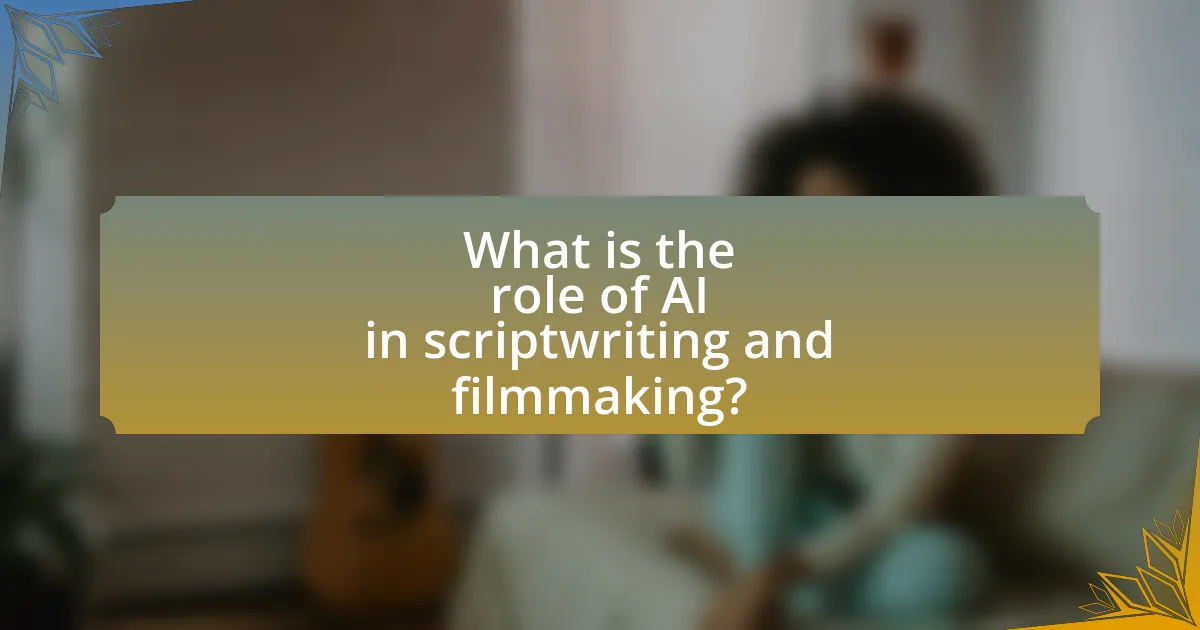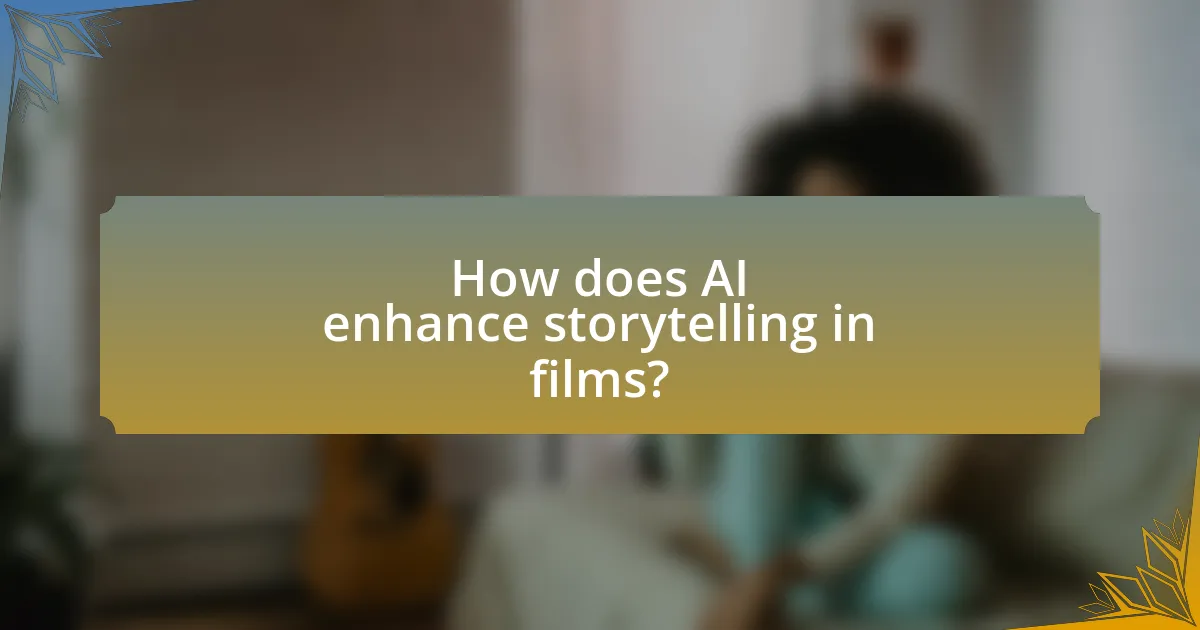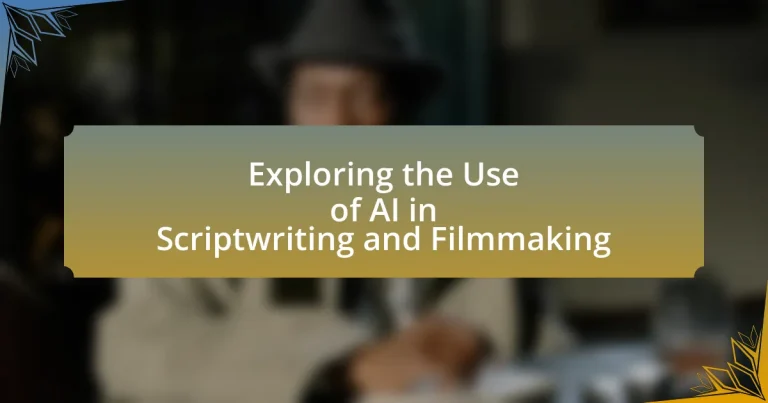The article explores the significant role of artificial intelligence (AI) in scriptwriting and filmmaking, highlighting how AI enhances creativity, streamlines production processes, and provides data-driven insights. It discusses the transformation of traditional scriptwriting through automation and data analysis, detailing specific tasks AI can assist with, such as dialogue generation and character development. Key technologies driving AI in filmmaking, including machine learning and natural language processing, are examined, along with the challenges and ethical concerns associated with AI-generated content. The article also addresses the future prospects of AI in the industry, emphasizing the need for filmmakers to adapt to these advancements and leverage AI tools effectively.

What is the role of AI in scriptwriting and filmmaking?
AI plays a significant role in scriptwriting and filmmaking by enhancing creativity, streamlining production processes, and providing data-driven insights. In scriptwriting, AI tools can analyze existing scripts to suggest plot developments, character arcs, and dialogue improvements, thereby assisting writers in generating compelling narratives. For instance, platforms like ScriptBook utilize machine learning algorithms to predict a script’s success based on historical data, helping writers refine their work. In filmmaking, AI aids in various stages, from pre-production planning to post-production editing, by automating tasks such as video editing, color correction, and even generating visual effects. A notable example is Adobe’s Sensei, which uses AI to enhance editing efficiency and creativity. These applications demonstrate that AI not only supports but also transforms traditional filmmaking practices, making the process more efficient and innovative.
How is AI transforming traditional scriptwriting processes?
AI is transforming traditional scriptwriting processes by automating content generation and enhancing creativity through data analysis. Tools like OpenAI’s GPT-3 can generate dialogue, plot ideas, and character development, allowing writers to explore multiple narrative possibilities quickly. Additionally, AI can analyze successful scripts to identify trends and elements that resonate with audiences, providing writers with insights that inform their storytelling. This integration of AI not only streamlines the writing process but also encourages innovation by offering new perspectives and ideas that may not have been considered in conventional writing methods.
What specific tasks can AI assist with in scriptwriting?
AI can assist with various tasks in scriptwriting, including generating dialogue, creating character profiles, and structuring plot outlines. For instance, AI tools can analyze existing scripts to suggest improvements or generate new content based on specific themes or genres. Additionally, AI can help in brainstorming ideas by providing prompts or scenarios that writers can expand upon. Research indicates that AI-driven tools can enhance creativity by offering unique perspectives and reducing writer’s block, thereby streamlining the scriptwriting process.
How does AI influence the creative decision-making in scriptwriting?
AI significantly influences creative decision-making in scriptwriting by providing data-driven insights and enhancing narrative development. By analyzing vast amounts of existing scripts, AI tools can identify successful plot structures, character arcs, and dialogue patterns, which assist writers in crafting compelling stories. For instance, AI algorithms can predict audience preferences based on historical data, enabling writers to tailor their scripts to meet viewer expectations. Additionally, AI can generate suggestions for plot twists or character development, thereby expanding the creative possibilities for writers. This integration of AI not only streamlines the writing process but also fosters innovation by offering new perspectives and ideas that writers may not have considered.
What are the key technologies driving AI in filmmaking?
Key technologies driving AI in filmmaking include machine learning, natural language processing, computer vision, and generative adversarial networks (GANs). Machine learning algorithms analyze vast amounts of data to identify patterns in audience preferences, aiding in script development and marketing strategies. Natural language processing enables AI to understand and generate human-like dialogue, enhancing scriptwriting efficiency. Computer vision technologies facilitate tasks such as scene recognition and visual effects automation, streamlining production processes. Generative adversarial networks are used to create realistic visual content, including deepfake technology, which can alter performances or create entirely new characters. These technologies collectively enhance creativity, efficiency, and audience engagement in filmmaking.
What types of AI algorithms are commonly used in scriptwriting?
Commonly used AI algorithms in scriptwriting include natural language processing (NLP) models, generative adversarial networks (GANs), and recurrent neural networks (RNNs). NLP models, such as OpenAI’s GPT series, analyze and generate human-like text, enabling scriptwriters to create dialogue and narrative structures. GANs can generate creative content by learning from existing scripts, while RNNs are effective in predicting sequences, making them suitable for developing plotlines. These algorithms have been validated through their application in various AI-driven writing tools, demonstrating their effectiveness in enhancing the scriptwriting process.
How do machine learning and natural language processing contribute to AI in filmmaking?
Machine learning and natural language processing significantly enhance AI in filmmaking by automating script analysis and generating content. Machine learning algorithms can analyze vast amounts of existing scripts to identify successful narrative structures, character development, and dialogue patterns, which can inform new scriptwriting. Natural language processing enables AI systems to understand and generate human-like dialogue, allowing for the creation of realistic characters and interactions. For instance, tools like ScriptBook utilize machine learning to predict a script’s box office potential based on historical data, demonstrating the practical application of these technologies in the industry.
What challenges does AI face in the scriptwriting and filmmaking industry?
AI faces several challenges in the scriptwriting and filmmaking industry, primarily related to creativity, emotional depth, and understanding cultural nuances. These challenges arise because AI systems often lack the ability to generate truly original ideas and may struggle to convey complex human emotions effectively. For instance, while AI can analyze existing scripts and generate content based on patterns, it may not capture the subtleties of character development or the intricacies of human relationships, which are crucial for compelling storytelling. Additionally, AI’s reliance on data can lead to biases, as it may inadvertently reinforce stereotypes present in the training data, limiting its ability to create diverse and inclusive narratives.
What ethical concerns arise from using AI in creative processes?
The ethical concerns arising from using AI in creative processes include issues of authorship, originality, and bias. AI-generated content can blur the lines of intellectual property, raising questions about who owns the rights to a work created with AI assistance. Additionally, the reliance on AI may lead to a lack of originality, as algorithms often generate content based on existing data, potentially resulting in derivative works rather than truly innovative ideas. Furthermore, AI systems can perpetuate biases present in their training data, leading to the reinforcement of stereotypes or exclusion of diverse perspectives in creative outputs. These concerns highlight the need for careful consideration of the implications of AI in creative fields.
How do filmmakers address the limitations of AI-generated content?
Filmmakers address the limitations of AI-generated content by integrating human creativity and oversight into the production process. They recognize that while AI can assist in generating ideas and scripts, it lacks the emotional depth and nuanced understanding of human experiences that are essential for storytelling. For instance, filmmakers often use AI tools for initial drafts or brainstorming sessions but rely on human writers to refine and enhance the content, ensuring it resonates with audiences. This collaborative approach combines the efficiency of AI with the irreplaceable insights of human creativity, leading to more compelling narratives.

How does AI enhance storytelling in films?
AI enhances storytelling in films by analyzing vast amounts of data to identify patterns and trends that resonate with audiences. This capability allows filmmakers to create more engaging narratives tailored to viewer preferences. For instance, AI tools can evaluate script elements, character development, and plot structures, providing insights that help writers refine their stories. Additionally, AI can assist in generating dialogue and suggesting plot twists, thereby streamlining the creative process. Research from the University of Southern California highlights that AI-driven analytics can predict box office success by assessing script quality and audience engagement metrics, demonstrating its effectiveness in enhancing storytelling.
What role does AI play in character development and dialogue creation?
AI significantly enhances character development and dialogue creation by analyzing vast datasets to identify patterns in storytelling and character traits. This technology can generate realistic dialogue that reflects the personalities and motivations of characters, ensuring consistency and depth. For instance, AI tools like OpenAI’s GPT-3 have been utilized in scriptwriting to produce dialogue that aligns with established character arcs, demonstrating the ability to mimic human-like conversation. Additionally, AI can assist writers by providing suggestions based on genre-specific conventions, thereby streamlining the creative process and improving narrative coherence.
How can AI analyze audience preferences to shape character arcs?
AI can analyze audience preferences to shape character arcs by utilizing data-driven insights from viewer interactions, social media sentiment, and engagement metrics. By processing large datasets, AI identifies patterns in audience reactions to specific character traits, story developments, and emotional arcs. For instance, machine learning algorithms can evaluate viewer ratings and comments on platforms like IMDb or Rotten Tomatoes, revealing which character attributes resonate most with audiences. This analysis allows writers to craft character arcs that align with audience expectations and emotional responses, ultimately enhancing viewer satisfaction and engagement.
What tools exist for AI-driven dialogue generation?
AI-driven dialogue generation tools include OpenAI’s ChatGPT, Google’s Dialogflow, and Microsoft’s Azure Bot Service. These tools utilize advanced natural language processing algorithms to create coherent and contextually relevant dialogues. For instance, OpenAI’s ChatGPT is based on the GPT-3 architecture, which has been trained on diverse datasets, enabling it to generate human-like responses in various conversational contexts. Google’s Dialogflow allows developers to build conversational interfaces using machine learning, while Microsoft’s Azure Bot Service provides a comprehensive framework for creating intelligent bots that can engage in dialogue. Each of these tools has been validated through extensive use in applications ranging from customer service to creative writing, demonstrating their effectiveness in generating dialogue.
How does AI contribute to plot structure and pacing?
AI contributes to plot structure and pacing by analyzing narrative patterns and optimizing story arcs based on audience engagement data. Through machine learning algorithms, AI can identify successful plot structures from vast datasets of existing scripts and films, allowing writers to create compelling narratives that resonate with viewers. For instance, AI tools like ScriptBook and Plotagon utilize predictive analytics to suggest pacing adjustments and plot developments that enhance emotional impact, ensuring that key moments align with audience expectations. This data-driven approach not only streamlines the writing process but also increases the likelihood of a script’s success in the competitive film industry.
What methods does AI use to evaluate narrative coherence?
AI evaluates narrative coherence primarily through natural language processing (NLP) techniques, including semantic analysis, discourse analysis, and machine learning models. Semantic analysis assesses the meaning and relationships between words and phrases to ensure logical consistency within the narrative. Discourse analysis examines the structure and flow of the narrative, focusing on how different parts of the story connect and contribute to overall coherence. Machine learning models, particularly those trained on large datasets of coherent narratives, can predict coherence by identifying patterns and features common in well-structured stories. These methods collectively enable AI to analyze and enhance the narrative quality in scriptwriting and filmmaking.
How can AI assist in creating engaging storylines?
AI can assist in creating engaging storylines by analyzing vast amounts of narrative data to identify successful plot structures and character arcs. For instance, AI algorithms can evaluate popular films and books, extracting patterns that resonate with audiences, such as conflict resolution and character development. This data-driven approach enables writers to craft compelling narratives that align with audience preferences, as evidenced by AI tools like Plotagon and ScriptAI, which utilize machine learning to generate story ideas and dialogue based on existing successful scripts.
What impact does AI have on visual storytelling techniques?
AI significantly enhances visual storytelling techniques by enabling more efficient content creation and personalized viewer experiences. Through machine learning algorithms, AI analyzes vast amounts of data to identify trends and preferences, allowing creators to tailor narratives and visuals that resonate with specific audiences. For instance, AI tools like Adobe Sensei automate editing processes, improving production speed and reducing costs. Additionally, AI-generated imagery and deepfake technology can create realistic visual effects and characters, expanding creative possibilities. Research from the University of Southern California highlights that AI-driven analytics can predict audience engagement, thereby informing storytelling strategies.
How can AI analyze visual elements to enhance storytelling?
AI can analyze visual elements by employing computer vision techniques to interpret images and videos, thereby enhancing storytelling. Through image recognition, AI identifies key visual components such as characters, settings, and actions, which can be used to create more engaging narratives. For instance, AI algorithms can analyze color schemes and composition to determine emotional tones, allowing filmmakers to align visuals with the intended mood of the story. Research from Stanford University demonstrates that AI can predict audience reactions based on visual cues, providing insights that help refine storytelling approaches. This capability enables creators to tailor their narratives more effectively, ensuring that visual elements resonate with viewers.
What are the implications of AI-generated visuals in filmmaking?
AI-generated visuals in filmmaking significantly enhance creative possibilities and streamline production processes. These visuals allow filmmakers to create complex scenes and effects that would be costly or impossible to achieve with traditional methods. For instance, AI can generate realistic backgrounds, characters, and special effects, reducing the need for extensive set designs and physical effects. A study by the Visual Effects Society indicates that AI tools can cut production time by up to 30%, enabling filmmakers to focus more on storytelling and character development. Additionally, AI-generated visuals can democratize filmmaking by making high-quality production accessible to independent creators, thus broadening the diversity of voices in the industry.

What are the future prospects of AI in scriptwriting and filmmaking?
The future prospects of AI in scriptwriting and filmmaking are significant, with advancements in natural language processing and machine learning enabling AI to assist in generating scripts, enhancing storytelling, and streamlining production processes. AI tools like OpenAI’s GPT-3 have already demonstrated the ability to create coherent narratives and dialogue, suggesting that future AI systems will likely become more sophisticated in understanding character development and plot structure. Additionally, AI can analyze audience preferences and trends, allowing filmmakers to tailor content more effectively, as evidenced by Netflix’s use of algorithms to predict viewer interests. This integration of AI not only enhances creativity but also increases efficiency in the filmmaking process, indicating a transformative impact on the industry.
How might AI evolve in the creative industries over the next decade?
AI is expected to evolve significantly in the creative industries over the next decade by enhancing scriptwriting and filmmaking processes through advanced algorithms and machine learning techniques. These advancements will enable AI to analyze vast amounts of data from existing scripts and films, allowing it to generate original content that aligns with audience preferences and industry trends. For instance, AI tools like OpenAI’s GPT-3 have already demonstrated the ability to create coherent narratives and dialogue, suggesting that future iterations will become even more sophisticated in understanding context and character development. Additionally, AI-driven analytics will provide filmmakers with insights into audience engagement, helping to tailor content more effectively. This evolution is supported by the increasing integration of AI technologies in production workflows, as seen in projects like “The Irishman,” where AI was used for de-aging actors, showcasing the potential for AI to transform not just storytelling but also the technical aspects of filmmaking.
What emerging trends in AI could influence scriptwriting and filmmaking?
Emerging trends in AI that could influence scriptwriting and filmmaking include the use of natural language processing for script generation, AI-driven analytics for audience engagement, and machine learning algorithms for predictive modeling of box office success. Natural language processing enables AI to analyze existing scripts and generate new content, streamlining the writing process. AI-driven analytics can assess viewer preferences and trends, allowing filmmakers to tailor their projects to audience demands. Additionally, machine learning algorithms can analyze historical data to predict which scripts are likely to perform well, guiding investment decisions in film production. These trends are reshaping the creative landscape by enhancing efficiency and aligning content with audience expectations.
How can filmmakers prepare for the integration of advanced AI technologies?
Filmmakers can prepare for the integration of advanced AI technologies by investing in training and education focused on AI tools and their applications in filmmaking. This preparation involves understanding how AI can enhance scriptwriting, editing, and visual effects, thereby improving overall production efficiency. For instance, a study by the University of Southern California highlights that filmmakers who adopt AI-driven tools can reduce post-production time by up to 30%, demonstrating the tangible benefits of AI integration. Additionally, filmmakers should collaborate with AI experts to develop customized solutions that align with their creative vision, ensuring that technology complements rather than replaces human creativity.
What skills will writers and filmmakers need to adapt to AI advancements?
Writers and filmmakers will need skills in data analysis, AI tool proficiency, and creative collaboration to adapt to AI advancements. Data analysis skills will enable them to interpret audience preferences and trends, which AI can provide through analytics. Proficiency in AI tools will allow them to leverage technology for script generation, editing, and visual effects, enhancing their creative processes. Additionally, creative collaboration skills will be essential as they work alongside AI systems, integrating human creativity with AI-generated content to produce innovative narratives. These skills are increasingly relevant as the film and writing industries evolve with AI technologies.
How can professionals in the industry leverage AI tools effectively?
Professionals in the industry can leverage AI tools effectively by integrating them into various stages of the scriptwriting and filmmaking process. For instance, AI can assist in generating script ideas, analyzing audience preferences, and optimizing production schedules. A study by the University of Southern California found that AI-driven analytics can improve decision-making in film production by up to 30%, demonstrating the tangible benefits of utilizing these technologies. Additionally, AI tools can enhance post-production tasks, such as editing and visual effects, by automating repetitive tasks, thereby allowing creative professionals to focus on more complex aspects of their projects.
What training resources are available for learning AI applications in filmmaking?
Training resources for learning AI applications in filmmaking include online courses, workshops, and specialized software tutorials. Platforms like Coursera and Udemy offer courses specifically focused on AI in creative industries, such as “AI for Creative Industries” by the University of London. Additionally, workshops hosted by organizations like the American Film Institute provide hands-on experience with AI tools used in filmmaking. Software companies, such as Adobe and Autodesk, also offer tutorials on integrating AI features in their filmmaking software, enhancing skills in areas like editing and visual effects.
What best practices should be followed when using AI in scriptwriting and filmmaking?
Best practices for using AI in scriptwriting and filmmaking include ensuring collaboration between human writers and AI tools, maintaining creative control, and utilizing AI for data-driven insights. Collaboration allows human creativity to guide AI-generated content, enhancing originality while leveraging AI’s efficiency. Maintaining creative control is crucial, as AI should serve as an assistant rather than a replacement, ensuring that the final product reflects the unique vision of the filmmakers. Utilizing AI for data-driven insights, such as audience preferences and market trends, can inform decision-making and improve the likelihood of success. These practices are supported by industry examples where AI tools have been effectively integrated, such as script analysis software that helps identify potential plot weaknesses or character development opportunities.


